Twenty six year Analysis of Fossil Fuel Related Highly Cited Works: A Web of Science Based Scientometric Profile
C Velmurugan*
Researcher, Department of Library and Information Science, Periyar University, India
Submission: April 04, 2018; Published: May 01, 2018
*Corresponding author: C Velmurugan, Department of Library and Information Science, Periyar University, Salem , Tamilnadu, India Email:
How to cite this article: http://dx.doi.org/10.19080/IJESNR.2018.10.555796.DOI: 10.19080/IJESNR.2018.09.555796
Abstract
The study tries to observe the characteristics of highly cited scholarly scientific publications in fossil fuel which was published by Indian scientists using the web of science database for period of 26 years from 1991 to 2016. A total of 943 scholarly literature was found using the search term was "Fossil fuels” in conjunction with the mane of the country "India". The analysis focus on fossil fuel research in India measuring in terms of total number year wise publications, citations, record count, citation per year, citation per paper, citation per author, authors per paper, and their h-index, g-index, hI-norm, hI-annual, etc based on the literature output using publish or perish software program. Further, this paper discusses the ranking of highly cited top 10 papers, institution and universities, countries participation, keyword analysis, and mapping of highly cited core journals and highly cited authors' contribution using VOSviewer visualization software during the study period.
Keywords: Highly cited papers; Fossil Fuel; Scholarly publications; WoS; Citation analysis; VOS viewer; Publish or perish; Scientometrics; Bibliometrics
Introduction
According to EIA [1], Fossil fuels are a combination of coal, petroleum (oil), and natural gas concentrated in the Earth's crust. They are created from the remains of plants and animals that lived millions of years ago in the form of concentrated biomass. The US Energy Information Administration (EIA) reports that fossil fuels meet 81 percent of U.S. energy demand [2]. Fossil fuels formed from the fossilized remains of dead plant which was first introduced by Georgius Agricola in 1556 and later by Mikhail Lomonosov in the 18th century. It is analyzed and found between 2013 and 2040, natural gas consumption is expected to increase by 13.4 percent and coal consumption by 5.6 percent. The EIA foresees fossil fuels maintaining their status as America's leading source of energy consumption between now and 2040, supplying 80 percent of our nation's energy needs in 2040. Major research institutes such as Institute for Energy Research, American Petroleum Institute[ Atomic and nuclear energy research in Indial, Energy harvesting research centers[ United States Department of Energy national laboratories!*etc. however, those developments have been rather slow and inadequate to meet the future challenges in the field of fossil fuel research. According to Levitt and Thelwall [3], “Citation counts can be considered an indicator of the impact a paper has. Papers attracting a large number of citations are of interest, because their citation suggests a particular influence on the development of science”. Citation rate distributions reveal important regularities and characteristics concerning the use of scientific information and the statistics on 'highly cited’ papers give important additional information on the high end of national citation impact Glanzel and Czerwon [4]. As there is no study in the domain of fossil fuel research, this topic is taken into consideration for the present study.
Literature Work
Based on the literature, it is found that there is no study in the field of fossil fuel pertaining to analysis of highly cited work. However, few studies were carried out on scientometric / bibliometric analysis of related research in India as well as global. Velmurugan [5] carried a study on Nephrology and found USA got ranked first with 845 research output and the percentage rate is 32.2 and also the global citation score was 5306 and the American Journal of Kidney Diseases was ranked first in terms of global citation score (5.5%). Velmurugan [6] examined the on Nephrology and found the range of collaborative index was from 0.15 to 0.19 during 2011-2016 and the maximum range of collaborative index was 0.19 in 2011. The degree of collaboration ranges from 0.79 to 0.91 and the average degree of collaboration was 0.86. The similar works have already carried out in single journals studies such as Journal of Information Literacy Velmurugan and Radhakrishnan [7] , Citation analysis of Webology journal Velmurugan [8], Journal of Intellectual Property Rights Velmurugan [9], Annals of Library and Information Studies Velmurugan [10] to make strengthen the present study [11]. Rezaee-Zavareh et al. [12] investigated ten year analysis of hepatoitis related scholarly publications which were extracted from the web of science database in the region of Middle East. Out of 103,096 articles using the term "hepatitis" in their title, abstract, or keywords, only 6,540 papers (6.34%) were connected with countries in the ME. The findings of the study showed that Turkey, Iran, Egypt, Israel, and Saudi Arabia were the top five countries in which hepatitis-related papers were published. Egypt was the most cited articles on HCV infections among the countries in the ME. Bauer; Leydesdorff and Bornmann [13] conducted a study on Library and Information Science and found twenty-three of the 798 LIS-authors were found on the highlycited.com list. Twelve of them contributed four or more papers to the papers analyzed in this study [14]. Nine were also authors of the top-1% papers among the LIS publications.
Rationale and Objectives
The main purpose of this study is to observe the characteristics of highly cited scholarly scientific publications in fossil fuel which was published by Indian scientists for period of 26 years from 1991 to 2016. The other objectives are:
a) To examine the characteristics of top 10 highly cited articles and their characteristics of fossil fuel literature
b) To identify the research activity of top 10 highly cited authors from different types of organizations
c) To verify the top 10 highly cited institutions and collaborative institutions and their performance
d) To analyze the top 10 highly cited core journals and productivity and mapping the network visualization
e) To observe the top 10 highly cited countries and their relationship and mapping the network visualization
f) To find out the top 10 highly cited keywords and their level of richness and
g) To evaluate the yearly output along with mean value of citations, cited references, authors and their level of h-index
Material and Methods
The required data was identified and extracted from the web of science core collection database which is run by Clarivate Analytics (formerly Thomson Reuters) for period of 26 years (1991-2016). A total of 943 scholarly literature was found using the search string was “Fossil fuels” and refined by Countries/Territories "India” and the time span between 1991 and 2016 which were indexed in SCI-Expanded, A & HCI. The data was retrieved in terms of various formats such as articles (69.9%), review papers (24.5%), articles in proceedings (4.6%), editorial materials (0.5%), Letters (3, 0.3%), article from retracted publication and notes (0.1%) each. Further, there are three softwares such as Publish or Perish (POP), HistCite and VOSviewer for mapping and trend line analysis have been applied to retrieve relevant output of this study.
Data Analysis
Publications Details as Per Publish or Perish (POP)
The collected records were transferred into publish or perish software developed by Harzing in October 2006 which is used to retrieve and analyze academic citations. Publish or perish (pop) measures in terms of total number year wise publications, citations, record count, citation per year, citation per paper, citation per author, authors per paper, and their h-index, g-index, hI-norm, hI-annual, etc based on the literature output. Publish or perish is used by many academicians to make a case of tenure, and promotion or other types of research evaluation.
Identification of Highly Cited Papers
Table 1 indicates the top 10 highly cited papers among the 943 literature output in fossil fuel which have been selected in each year with their paper number as per the HistCite software accordingly it has been analyzed. Each paper describes about their nature of publication, document type, where is has been published and their journals, volume and issue number along with page numbers and global level citations during the period of study. It is measured the year wise highly cited papers of global citations and their cited references were retrieved for analysis. Accordingly, the highly cited articles were gathered the chosen period from 1991 to 2016. The findings of the study observe that the major proportion of global citations 1415 with 43 cited references which are published in 'Renewable & Sustainable Energy Reviews’ in 2006. It is also noted that the highly cited articles were not found and only very few citations were identified during the years 1992, and 1994, 1995 and 1996.
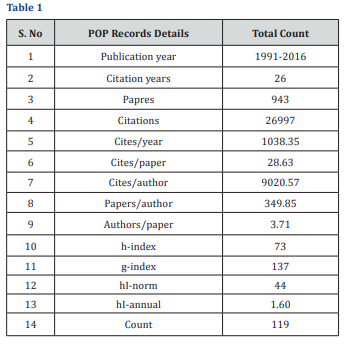
Ranking of Top 10 Highly Cited Authors on Fossil Fuel
Table 2 describes the ranking of highly cited authors in fossil fuel literature in Indian perspectives. This study provides the detailed ranking of authors in terms of total records, local citations, global citations, total cited references etc. Among the top 10 highly cited authors, the majority of 1825 global citations with 12 (1.3%) publications received by “Venkataraman C' and he has ranked first and followed by the second productive author is 'Naik SN' and his global citations is 1530 with only 4 papers. The third major proportion of global citations had got by 'Meher LC' with 1415 by only one (0.1%) paper. The results reveal that maximum number of global citations of fossil fuel research in India is received by Venkataraman C throughout the study.
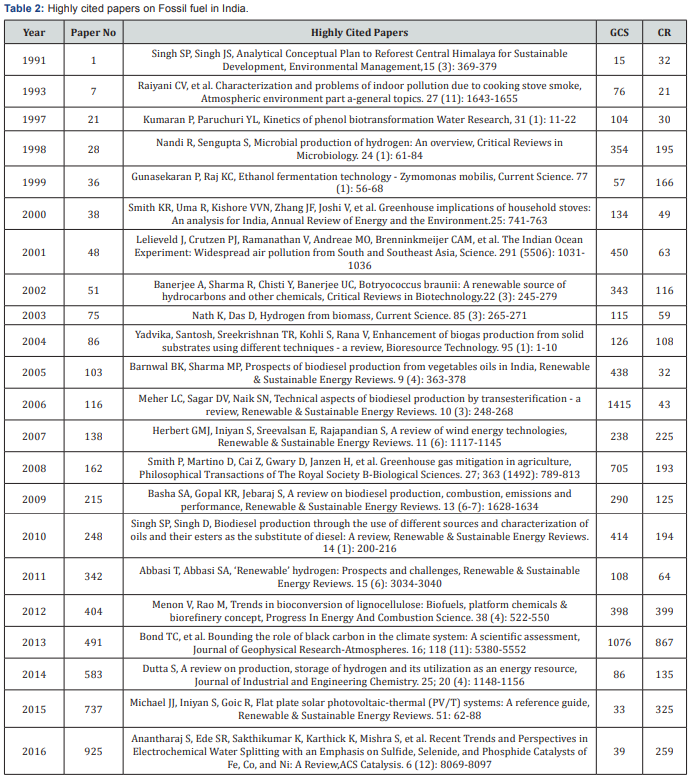
Ranking of Top 10 Highly Cited Institutions
It is analyzed ranking of highly cited institutions and universities in terms of scholarly publications in the field of fossil fuel. Table 3 depicts that only top 10 highly cited more than 1000 global citations from academic institutions, IITs, IIM, R & D Research institutions were selected for the present study. The findings show that most of highly cited papers 136 (14.4%) were from IITs with 6983 global citations among the top 10 highly cited institutions and ranked first. CSIR has placed second with 1592 global citations with 32 (3.4%) papers and followed by Max Planck Inst Chemistry got ranked third with 1544 global citations with only three papers. The results indicate that most of the academicians from Universities are not interested to involve in research activities in the field of fossil fuel during the study period.
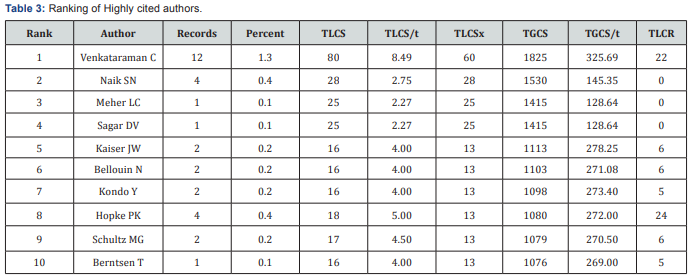
Ranking of Most Productive Top 10 Countries in Fossil Fuel
Table 4 indicates the ranking of highly cited countries based on the output of global citations in fossil fuel research. For the purpose of analysis, it has been chosen top 10 countries with more than 1000 global citations. As this study is associated with Indian scientists, India is the huge proportion of 26584 (98.6%) highly cited global citations with 930 literature output and occupies first rank. The next highly cited records of United States with 65 count and their global citations is 3897 and followed by the third highly cited papers i.e. 11 with 2132 global citations among the top ten countries. Countries such as Japan (1518), Austria (1153), Norway (1113), Switzerland (1113) and Canada (1111) were found least amount of citations and ranked below 5 to 10 th position.
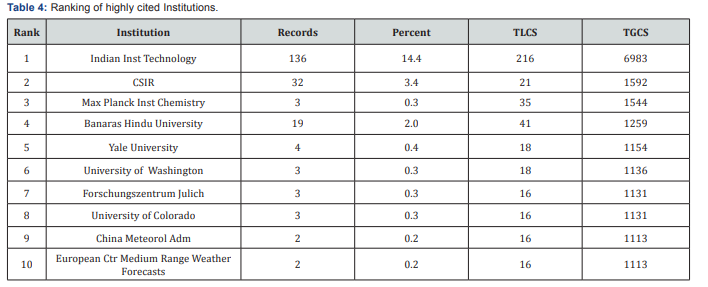
Mapping of Citations and Countries
For mapping the citations and countries, it is applied the vos viewer visual software. Based on that the type of analysis is selected as citation and the unit of analysis is selected as countries with minimum number of documents of a country are 2 record counts (Figure 1).

Identification and Ranking of Core journals
Table 5 provides the information about the core journals and their ranking based on the total global citations and their h-index. In order to identify and measure the output of fossil fuel journals literature, it has been taken only top 10 highly cited core journals with more than 300 citations. It is found that the huge number of 6806 total global citations cited by the core journal of 'Renewable & Sustainable Energy Reviews' with 122 (12.9%) research papers ranked first and its h-index is 36. The next productive core journal is 'Journal of Geophysical Research- Atmospheres' and its global citations was1698 with 17 (1.8%) research papers along with h-index is 15 and occupies second rank and followed by the third highest proportion received by the journal is 'Atmospheric Environment' with 1157 global citations with 30 (3.2%) articles and their h-index is 16. It is also counted small amount of research literature and found the journal i.e., Progress in Energy and Combustion Science got 10th rank with 493 global citations based on the literature output 2 (0.2%) and their h-index is 2.
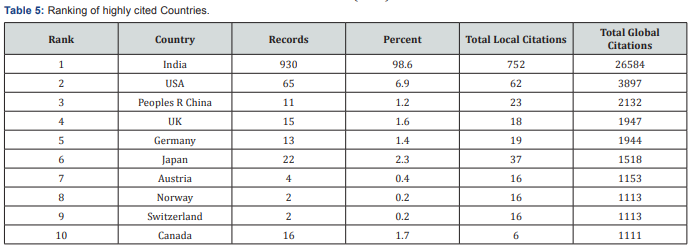
Mapping of Source Wise Co-Citation
In order to map the source wise citation, it is used the vos viewer visual software. Based on that the type of analysis is selected as co-citation and the counting method is chosen as full counting and the unit of analysis is selected as sources with minimum number of citation of a cited reference are 20 records (Figure 2).

Ranking of Highly Cited Keywords on Fossil Fuel Literature
It is inferred from the Table 6 shows the ranking of highly cited keywords on fossil fuel research of India. Out of 12, 601 word count, only top 10 highly cited more than 2000 words have been chosen for the present study. It is analyzed based on the h-index and found the huge number of highly cited keyword is 'India' with 4, 515 global citations with 177 papers, 713 authors, 7681 cited references and its h-index is 37 which is ranked first. The next productive highly cited keyword is 'review’ with 6460 global citations with 98 papers, 311 authors, 5093 cited references, and their h-index is 36 and followed by the third rank goes to 'production' with 6674 global citations with 131 papers, 468 authors, 11211 cited references, and their h-index is 34 among top 10. But, compare with global level citations in terms of keywords, the keyword 'production' with 6674 citations with 131 research papers and 'India' is ranked fourth compare with global citations. It is also counted mean value of authors and cited references, and found huge mean value of authors is 5.24 with keyword is 'carbon'. Figure 3 shows the highly cited keywords on fossil fuel scientific publications and it has been evaluated based on the trend line analysis in terms of exponential growth rate and the y values is 7409.9e-0142x and the R2 value is 0.8678. The result indicates that the growth rates of total global citations are exponentially increased during the period of study.

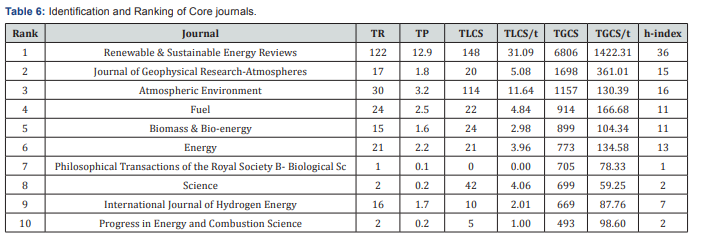
Evaluation of Yearly Citations, Cited References, Authors and Their h-Index
Table 7 represents the year wise global citations distribution of fossil fuel literature and their mean value of citations, cited references, authors and their h-index has been computed Table 8. It is analyzed the major proportion of highly cited papers on fossil fuel literature, and its mean value, highly cited references and its mean value, number of author and their mean values and h-index were measured. The results of this study reveal that the range of global citations is from 7 to 3385 and the range of number of authors is from 5 to 792 and the range of cited references is from 0 to 15242 and the range of h-index is from 1 to 31 in terms of yearly output on fossil fuel research in India. The maximum number of h-index is 31 received in 2010 with 64 papers and their global citations are 3385. The majority of authors found in the year 2016 with 190 research output and the huge number of cited references is 15242 and their global citations is 845. It is also identified and counted the mean value of global citations and presented (Figure 4).
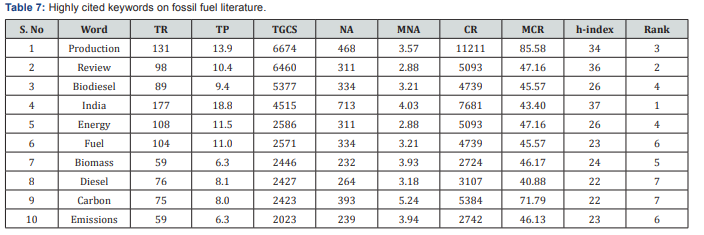
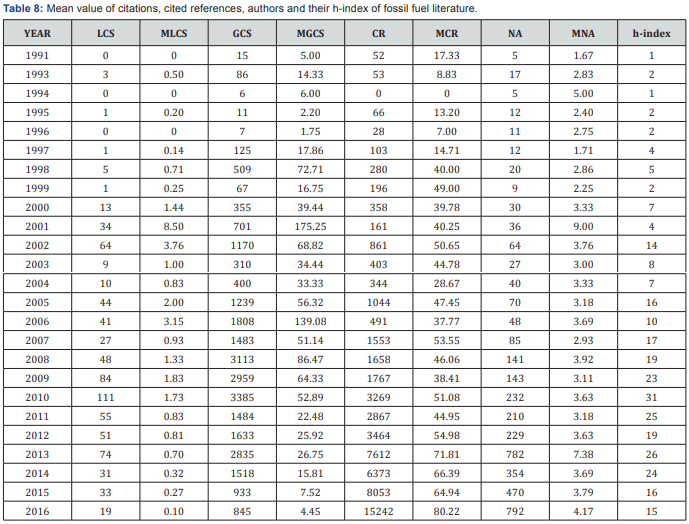

Conclusion
Generally, metric studies such as librametrics, informatrics, bibliometrics, are focused the evaluation based analysis. Scientometrics is one the metrics which is widely used to measure and count the literature output in any subject or topic, institutional research, R&D, IITs, and IIMs of current research trends using various bibliometric databases like Web of Science, Scopus, Pubmed etc. In this context, the major findings are listed that the huge proportion of global citations 1415 with 43 cited references which are published in 'Renewable & Sustainable Energy Reviews'. Among the top 10 highly cited authors, the majority of 1825 global citations with 12 (1.3�x0025;) publications received by 'Venkataraman C' and he has ranked first. Most of the highly cited papers (14.4�x0025;) were from IITs with 6983 global citations and ranked first. CSIR has placed second with 1592 global citations. India is the huge proportion of 26584 (98.6�x0025;) highly cited global citations with 930 literature output and occupies first rank and the next highly cited records of United States. Therefore, it is believed that both the quantity and quality of fossil fuel related scholarly scientific publications in India should be improved. It is suggested that implementing national as well as international projects, conducting conferences and congress meetings, and educational workshops and publishing highly quality research journals will help to improve the status in research effectively.
References
- (2016) Energy Information Administration, Monthly Energy Review.
- (2015) Energy Information Administration, Annual Energy Outlook.
- Levitt JM, Thelwall M (2009) The most highly cited Library and Information Science articles: Interdisciplinarity, first authors and citation patterns. Scientometrics 78(1): 45-67.
- Glanzel W, Czerwon HJ (1992) High citation what are highly cited publications? A method applied to German scientific papers, 19801989. Research Evaluation 2(3): 135-141.
- Velmurugan C (2018) Nephrology Research Performance of Indian Scientists in Science Citation Index Expanded: A Scientometric Profile. JOJ uro & nephron 5(2): 1-6.
- Velmurugan C (2017) An Application of the Bibliometric Law of Fossil Fuel Literature in Science Citation Index Expanded. Organic and Medicinal Chemistry: International Journal 4 (5): 1-4.
- Velmurugan C, Radhakrishnan N (2015) Journal of Information Literacy: A Scientometric Profile, Journal of Information Sciences and Application 3(1): 1-9.
- Velmurugan C (2014) Research Trends in Indian Journal of Pure and Applied Physics (IJPAP) for the Year 2009-2012. Asian Review of Social Sciences 3 (1): 24-28.
- Velmurugan C (2013) Research Trends in Journal of Intellectual Property Rights (JIPR): A Bibliometric Study. Library Philosophy and Practice (e-journal) pp. 1043.
- Velmurugan C (2013) Scientometric analysis: Annals of Library and Information Studies Publications Output during 2007-2012, International Journal of Library and Information Studies 3(3): 58-65.
- Thavamani K, Velmurugan C (2014) Citation analysis of Webology journal during: 2004-2012. International Journal of Library and Information Studies p. 1-7.
- Rezaee-Zavareh (2016) Ten year analysis of hepatitis-related papers in the Middle East: a web of science-based scientometric study, Turk J Gastroenterol p. 1-6.
- Bauer J, Leydesdorff L, Bornmann L (2011) Highly cited papers in Library and Information Science (LIS) Authors institutions and network structures. Journal of the Association for Information Science and Technology p. 1-16.
- Fossil Fuel.






























